Ionic Gel Actuator
September 6, 2013
Electromagnetic loudspeakers have been with us from the time of
Alexander Graham Bell's telephone patent of 1876. As an illustration of the
patent attorney's concept, "as known to those skilled in the art," a loudspeaker is just a refinement of a
telegraph sounder to reproduce
analog signals.
Radios and
phonographs of the early
twentieth century had huge loudspeakers, not because they were designed to be loud, but because the loudspeakers had weak
magnets and were
inefficient. Loudspeakers function because of the attractive and repulsive forces between a
permanent magnet and the
magnetic field produced in a
coil of wire, so the intensity of the permanent magnet is important.
The best magnets at the time were made from an
alloy called
Alnico V, which has a much smaller
magnetization than today's
rare-earth magnets. Alnico, as its name indicates, is an alloy of
aluminum,
nickel and
cobalt, and the nickel and cobalt content makes these magnets expensive. Nevertheless, they were still better than earlier
iron-based magnets.
Not long after the 1969 discovery of the
piezoelectricity of the
ferroelectric polymer,
polyvinylidene fluoride (PVDF), there was development of
piezoelectric loudspeakers. Although these are good for alarm and mobile applications, they haven't replaced traditional electromagnetic speakers in
hi-fi applications.
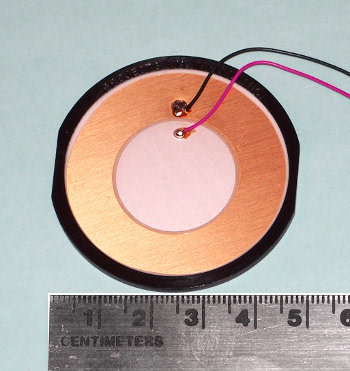
This is a speaker with a piezoelectric actuator formed from a lead zirconate titanate (PZT) ceramic.
The PZT is the white disk in the center of a brass diaphragm.
The PZT is coated with a thin silver layer on the top as one electrode, and the brass is used as the bottom electrode.
(Photo by the author.)
By simple
electrostatic attraction, you can generate a
force between parallel plates without needing any special material property such as piezoelectricity. Any
capacitor, including capacitors without a
dielectric, will have a force between its plates proportional to the square of the applied
voltage. A dielectric with
constant κ will amplify the force, as shown in the figure. The dielectric constant of a
vacuum is one.
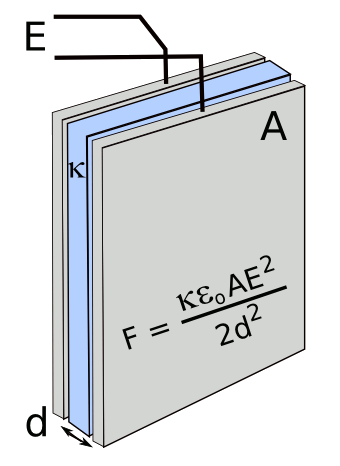
Force F between the plates of a parallel plate capacitor.
The capacitor plates, energized with voltage E, have area A and are separated by distance d.
κ is the dielectric constant of the material between the plates, and εo is the permittivity of free space, also called the vacuum permittivity.
(Image by author, rendered using Inkscape.)
Harvard University scientists from the
Harvard School of Engineering and Applied Sciences, the
Wyss Institute for Biologically Inspired Engineering, the
Kavli Institute for Bionano Science & Technology, and the Harvard
Materials Research Science and Engineering Center have used this effect to make a
transparent actuator formed from a dielectric
elastomer sandwiched between a pair of electrodes formed from soft,
ionic hydrogels.[1-3] The hydrogel electrodes do not impose any mechanical constraint on the motion of the dielectric.
Their demonstration actuator, a transparent loudspeaker, was built from very simple materials. The ionic conductor is a
polyacrylamide gel swollen with
salt water, and such a
conductor has advantages over other materials.[3] It can be stretched to many times its area without an increase in
resistivity, it's transparent, and it's
biocompatible. The biocompatibility means that the actuators can be used as
artificial muscles or as
implantable devices.[3]
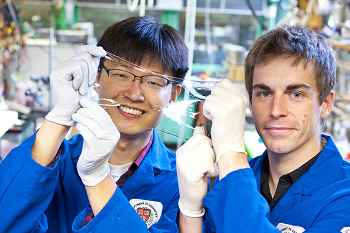
Jeong-Yun Sun (left) and Christoph Keplinger demonstrate the stretchability of a transparent, ionically conductive material.
(Harvard University photograph by Eliza Grinnell/SEAS Communications.)[3)]
The demonstration loudspeaker, which has a response over the entire
audio frequency range, does require 10
kilovolts for operation.[1] Despite the high voltages used, there is no
chemical degradation of the device, since the
insulating elastomer layer limits the
current flow.[3] Says study co-lead author,
Jeong-Yun Sun, a
postdoctoral fellow at the Harvard School of Engineering and Applied Sciences,
"It must seem counterintuitive to many people, that ionic conductors could be used in a system that requires very fast actuation, like our speaker... Yet by exploiting the rubber layer as an insulator, we're able to control the voltage at the interfaces where the gel connects to the electrodes, so we don't have to worry about unwanted chemical reactions."[3]
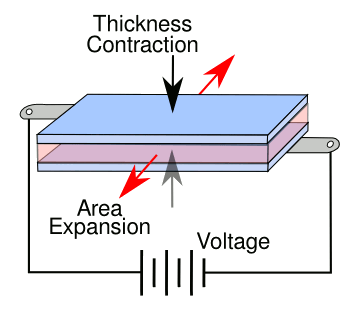
Harvard University ionic gel actuator.
The elastomer, shown in pink for clarity in this image, is actually transparent.
(Image by author, rendered using Inkscape.)
Christoph Keplinger, the study's other co-lead author described one possible application, a
noise-canceling window. "You could potentially place this speaker on a window and achieve active noise cancellation, with complete silence inside."[3] This research was supported by the
National Science Foundation through a grant to the Materials Research Science and Engineering Center at Harvard University, and by the
Army Research Office.[3]
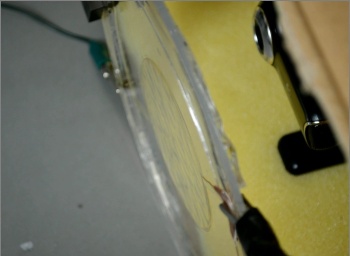
An ionic gel loudspeaker under test.
(Still image from a Harvard University video.)[3]
![]()
References:
- Christoph Keplinger, Jeong-Yun Sun, Choon Chiang Foo, Philipp Rothemund, George M. Whitesides and Zhigang Suo, "Stretchable, Transparent, Ionic Conductors," Science, vol. 341, no. 6149 (August 30, 2013), pp. 984-987.
- John A. Rogers, "A Clear Advance in Soft Actuators," Science, vol. 341, no. 6149 (August 30, 2013), pp. 968-969.
- Caroline Perry, "Transparent artificial muscle plays music," Harvard Gazette, August 29, 2013.
Permanent Link to this article
Linked Keywords: Electromagnet; electromagnetic; loudspeaker; Alexander Graham Bell; telephone; patent; patent attorney; telegraph sounder; analog signal; radio; phonograph; twentieth century; magnet; energy conversion efficiency; inefficiency; permanent magnet; magnetic field; solenoid; coil of wire; alloy; Alnico V; magnetic field; magnetization; rare-earth magnet; aluminum; nickel; cobalt; iron; piezoelectricity; ferroelectric polymer; polyvinylidene fluoride; piezoelectric loudspeaker; high fidelity; hi-fi; lead zirconate titanate; brass; diaphragm; silver; electrode; electrostatics; electrostatic; force; capacitor; dielectric; voltage; relative permittivity; dielectric constant; vacuum; permittivity of free space; Inkscape; Harvard University; scientist; Harvard School of Engineering and Applied Sciences; Wyss Institute for Biologically Inspired Engineering; Kavli Institute for Bionano Science & Technology; Materials Research Science and Engineering Center; transparency and translucency; transparent; actuator; elastomer; ion; ionic; hydrogel; polyacrylamide; salt water; conductor; electrical resistivity and conductivity; biocompatible material; artificial muscle; implant; implantable; Jeong-Yun Sun; Christoph Keplinger; Eliza Grinnell; audio frequency; kilovolt; chemical decomposition; chemical degradation; electrical insulator; electric current; postdoctoral fellow; active noise control; noise-canceling; window; National Science Foundation; Army Research Office.